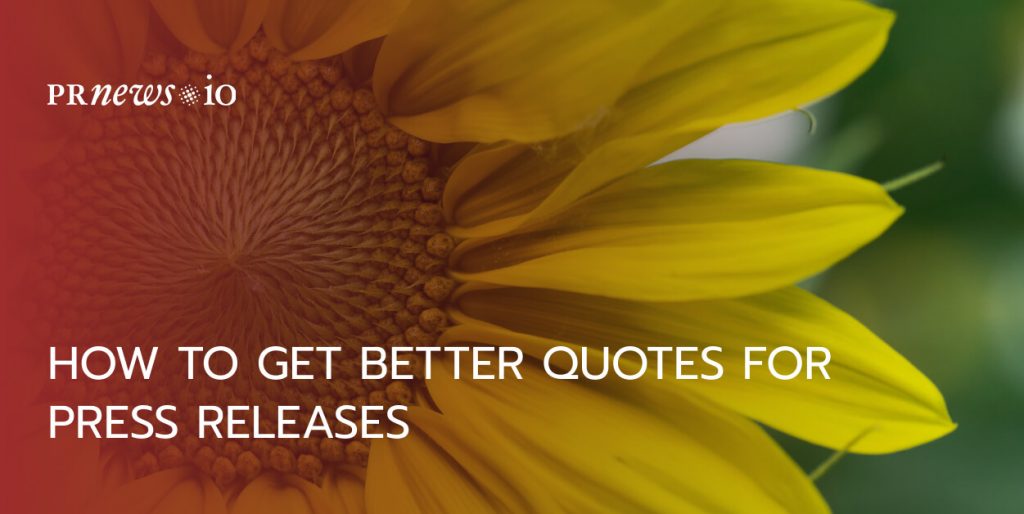If I only had two dollars left I would spend one dollar on PR.
— Bill Gates, founder of Microsoft

Press release quote. Quotes are not only essential but also an indispensable element of the press release. The problem is that some advertising copywriters (especially beginners) either do not understand the importance of quotes and therefore ignore them or insert such statements into the text that it would be better not to do at all.
When writing a press release, it is crucial to remember that you are trying to capture the media’s attention. Make sure that your press release is newsworthy and engaging. One way to do this is to include quotes from knowledgeable sources. When quoting someone in a press release, attribute it correctly.
Business copywriters should understand that a quote is a powerful tool for attracting attention, persuasion, and building a brand or company’s image.
And the quote in the press release is the only fragment where emotions are allowed. The statement, which carries essential, compelling information, attracts the reader.
How to Write Press Release – Guidelines, Formats, Free Samples
What Gives a Press Release Quote?
We need quotes not only for emotions but to express an expert assessment of events and opinion leaders’ positions. Sometimes the expert’s opinion contains important additional facts or figures. All this is extremely important for the press:
This is an opportunity to highlight our newsmaker, pay attention to him and insert him into the text, even if the information guide itself is not directly connected with this person.
Secondly, this is an opportunity to develop your leader’s image, investing in strong and powerful formulations, vivid, interesting thoughts in his mouth, etc.
Thirdly, this is a tool for developing the image of the company. After all, if the company has a bright leader who speaks well, then, therefore, the company is interesting and attractive because a strong leader is unlikely to lead a weak company.
Fourth, this is the only place in the press release where any emotions are allowed. Nowhere else can we afford this; you can not give any estimates, give comparisons and use “sharp” phrases. And here you can. Unlike the rest of the text, the quote is not intended for a journalist but immediately for the final reader.
Strong emotions are what grip journalists. They understand how to feed the reader. A bumpy quote, clinging quote, or sometimes even a sharp quote, can attract the editorial staff’s attention more than pathos info pods.
“PR writing is so horribly consistent — or consistently horrible — that agencies even have a template for it.”
Mark Ragan, president, Ragan Communications
What Should Be Press Release Quotes?
When picking up quotes for a press release, remember that they should not be boring or lengthy. It is good if the quote gives an unexpected assessment. Press release quotes must be short but, at the same time, bright and meaningful.
The worst mistake is to try to sell a company, goods, or services through quotes.
Let’s take a closer look at what the quote should be in the press release:
Be an information guide. Press release quotes should complement the main text of the news release and provide crucial information. Provide specifics, new details, or a unique, unusual look in the speaker’s direct speech, and then the quote sharply strengthens our text and performs a role.
It must be viral. I’m talking about cases when the quote becomes a winged or even a meme, a good bit of a phrase you want to repeat. It must contain a memorable image that will cling to the reader.
New details, an unexpected look at what is happening — all this is a great way to make your press release quote noticeable and provide it with a path to publication.
Most Common Mistakes — Don’t Underestimate
The direct speech of the newsmaker—the quote is an excellent trigger for the press release. Sometimes the news itself is not very good, but a bright emotional quote can change everything: the journalist will want to take it to publication. But for this, the PR officer must try.
Let’s talk about what mistakes are most often made by PR specialists when working with quotes.
One of the top two abilities lacking in entry-level PR pros: strong writing skills.
WorkInPR survey
Take the Words of Your Speaker into a Quote
Of course, there are such newsmakers whose every word is like gold. And the task of the PR player is to catch every statement and not let it disappear. But this is more of an exception. Most bosses, as a rule, do not understand anything in communications.
Your speaker, most likely, narrowly sings the praises of the brand instead of speaking in the essence of a specific case, which is the basis of the release. And if you remove the phrases “best in the industry,” “market leaders,” and “trustworthy partner” from his speech, there will be very little text left.
Quote as a Part of the Press Release Text
In order not to bother and save time, many PR workers insert a text into the direct speech, which could simply be the text of a press release, that is, current information like statistics and some interesting facts. And then it is not clear: why do you need such a direct speech at all?
A quote is a unique place in the release; it’s the only place you can really add emotion. Draw a bright picture. Do not kill quotes with statistics and passing information. If your quote cannot add a story of value, let it not be better.
Verbosity
Having learned that there should be a quote in the press release, many PR workers are trying to put almost half of the release into direct speech.
The longer the quote, the smaller number of readers it has. If you want anyone to pay attention to your leader’s speech, reduce the quote to a minimum. One small paragraph. Then it will stand out. Then it will look easy to read, and the journalist will not jump to the next release.
Publicity is absolutely critical. A good PR story is infinitely more effective than a front page ad
Richard Branson
Immerse in the Emotions
When speakers report some achievements of the company, they adore the use of formulations like “I am very pleased to realize…,” “I am very proud to imagine…,” “I am unusually excited..,” etc. It’s not interesting to anyone. It doesn’t add value to the news. Does not carry any business meanings. And it doesn’t make history more interesting.
The quote should not worry the director but the reader. Then it makes sense.
Too streamlined quote
Many leaders (especially in state and municipal posts) live on the principle of “it’s better not to rock the boat.” And this position leads to the fact that all bright and sharp moments from the quote are deleted.
In this version, it is better to abandon the quote or even the entire press release as a whole.
Show, not tell
Don’t tell the reader that your product is innovative and cutting-edge. Tell us exactly what it’s doing and how it works. How does it improve the life of the consumer? And show the innovation. Describe the process and result. Draw a picture in the reader’s head. It’s better than any epithet.
Decorate stories with bright, clinging, emotional quotes that bear value and increase significance.
Content Marketing Platform
- 100,000+ media publications;
- get backlinks to your product;
- scale work with content distribution.
Industry Experts about Press Releases Quotes
George Driscoll, Senior Digital PR Consultant, Root Digital

It’s useful to provide questions to your experts that will guide them to certain responses. You shouldn’t change their meaning or force an opinion on them, but often, experts will write too much, and you want to condense their knowledge succinctly into a useful bitesize comment journalist will love, guidance helps a lot here. Keep comments short and ensure they get to the point quickly providing value to readers and journalists. Consider who/what/when/where/why/how when reviewing and asking for quotes to help get the most from your experts.
Typically, you should place the quote toward the end of the press release before any notes to editors, however, if the quote is integral to your story and supports your offering further, you can use them closer to the beginning, but journalists often do not expect this format and it can detract from the facts in your press release.
Josh Pelletier, Chief Marketing Officer at BarBend

Select the ones that have a distinct character.
If the quote you choose reads like a story, I don’t think it works. Quotes that just inform should be avoided. It is important for a quote to make the reader feel something. If it sounds boring, it probably is. Keep looking. For maximum effectiveness, aim for a conversational tone. That’s how you add a story with depth and authenticity. Read some news articles and underline the parts that particularly resonate with you. Get a sense of the types of quotes that can captivate an audience by reading this. When a quote has a real impact, it practically leaps off the page. It provides context for what would otherwise be a dry account of the events. In addition to adding depth to your press release, this will also help to establish its reliability. When someone gives their permission to be quoted, it shows that they are willing to be held accountable for their words.
Sinoun Chea, a digital marketing consultant and CEO of ShiftWeb

Including a quote in a press release is a great way to add an extra layer of interest and expertise to your story. Just be sure to use them judiciously.
Here are some tips:
You can highlight the quote in your press release by italicizing it and putting the author’s name in bold. This will help the reader notice the quote and make it stand out from the rest of the text.
For example, you could format it this way: “The most important thing in a press release is the headline,” said John Smith, CEO of XYZ Corporation.
For effective placing, you can also put the quote near the beginning or end of your press release, depending on its relevance to your story. Make sure the expert you’re quoting is relevant to your story. Their quote should add value and help support your main message.
When possible, include a direct quote rather than a paraphrase. This will make your press release more interesting and engaging for readers. It will also add more emotions to your story.
If you’re quoting someone from an organization, be sure to include their title and affiliation. This will give your quote more context and help readers understand why they should care about what the person is saying.
Finally, make sure you proofread your press release carefully before sending it out. This includes checking for any errors in the quote itself. A well-crafted quote can add a lot of value to your press release – but only if it’s accurate.
Jeff Sherman, Founder, and Owner of Top Marketing Agency

I find quoting someone in a press release like you’d see it appear in an article is a good way to do it. You can make a journalist’s job easier by templating your press release and the quotes included just as they would while writing.
Journalists do it like this:
- Introduce the person you will be quoting (who are they and how do they fit into the story).
- Set up the topic they will be talking about and lead in accordingly to their quote. This is a place to include some information that the quoter referred to but maybe isn’t in their actual quotes.
- The quote comes next.
- Somewhere inside or after the quotes, you should reapply credit for the quotes so there is no confusion and it is clear to the reporter.
If you come back to this same person and quote them again, then just re-introduce them quickly by first or last name.
Dean Lee, Head of Marketing at Sealions

Exclamation points.
I find it pretty shocking how many CEOs are using words like “delighted,” “excited,” and “thrilled.” Of course, they are that is why the release is being issued but come up with a more effective phrase. Journalists really wouldn’t be waiting for more of the same if they got a pound for each release that contained one of these terms. In my experience, the words “unrivaled,” “unparalleled,” “amazing,” “first-class,” and “great” are all significant no-nos when they are used in quotations or, for that matter, when they are used anywhere else in a press release. Quotes should be used to express thoughts. It’s possible that the spokesperson thought the new product or launch was fantastic, but bragging about your accomplishments rarely works. To convey your point more discreetly, consider employing features and advantages.
Natalia Morozova, Managing Partner at Cohen, Tucker & Ades P.C.

Capture the essence of a statement as concisely and briefly as possible. One sentence is usually enough, two is fine, and three is too long. Curated quotes—short phrases featuring powerful words that state your position in a stark manner always make for great press release quotes.
Quotes in a press release can inspire readers to follow up with the desired behavior; they make great calls to action, so quotes are particularly effective towards the end of a press release.
Kiara McKinney, Founder of Boost PR

Quotes often work best after the introduction paragraph and before the conclusion paragraph. Both quotes should be used to offer context to the announcement, ideally from two different stakeholders.
The quotes should provide further details about what the announcement means for the company or organization and how they plan to move forward. The goal is to include quotes that offer a human element to the story.
Carl Jensen, Founder of Compare Banks

If you want to quote someone in a press release, use the following format: Person’s name (last name first) followed by “quote” or “quotation..” For example: “Mr. John Smith says…” The quotes should be placed at the end of the sentence and not inside it. If you need to include attribution, put it after the quotation (e.g., Mr. Smith said that). You can also add a footnote if you wish; see below for more details on footnotes and endnotes. Do not use any other punctuation marks—not even periods—inside quotes.
Once, I was working on a press release about using liquid nutrients to enhance the growth rate of marijuana plants.. My client wanted to show people that liquid nutrients could boost their results. To explain this, I put a line of text directly under the image: “Using these liquid nutrients can increase yields by 5-15%”. Then I figured out what would work best for me: a quote box at the top of the page.. That way, the quote would be on top of the image rather than underneath, meaning it wouldn’t get covered up. At the bottom of the page, I added the phrase “Source: www.mycannabisnews.com,” just above the link back to our site.
That’s not the only thing you should consider while putting quotes in a press release. As long as they complement the presented information, they’ll look fantastic!
FAQ: Press Release Quote
How to write a quote in a press release?
Highlight the quote in italics and the author of the words in bold — so they will immediately be noticeable, and the reader of your release will easily detect them, and the monotony of the overall text will be diluted.
How To Do Public Relations For Small Business
How to use PRNEWS.io
In this video, I share a great tool called PRNEWS.IO – a marketplace where PR specialists, internet marketers, and advertisers can buy sponsored content. PR is great for visibility, business growth, and SEO backlinks (it can help you rank in Google)
Read more:





